What you should pay attention to when putting your baby to bed
All breastfeeding support is about latching on. In fact, many breastfeeding problems are caused by various latch-on mistakes. In this blog article, I would like to discuss the most important aspects that you can easily consider when breastfeeding your baby.
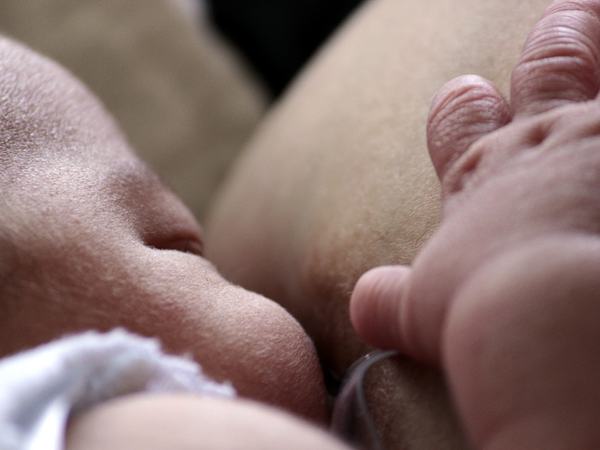
If at any point you have difficulty implementing my tips, you can contact a lactation consultant in your area. Some lactation consultants also work online, so you can contact them regardless of location.
This article in my podcast Connected
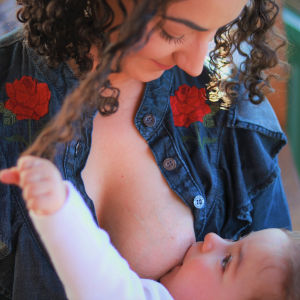
What to look for when putting your baby to sleep
In this episode, learn what to look for when breastfeeding your baby.
Summary of content
Comfortable position
The key to good latch-on is finding a comfortable position for you as a mom. It doesn't matter in which position you breastfeed. You always bring your baby to you for this and do not bring your breast to the baby.
As a rule, breastfeeding sessions last more than a minute and an uncomfortable position quickly becomes torture and leads to tension. Those who breastfeed in uncomfortable positions have little patience and desire to breastfeed, which leads to more and more frustration.
However, an uncomfortable breastfeeding position also has a direct impact in terms of breastfeeding itself. In a comfortable breastfeeding position, you sit or lie relaxed and the milk can flow well. If you are not sitting or lying comfortably, you automatically tense various muscles, even if you don't want to.

As a result, the milk-giving reflex is delayed. The milk-giving reflex causes the milk to flow more easily because sucking sets in motion a reflex mechanism at the hormonal and muscular level. Incidentally, this reflex is triggered several times during a breastfeeding session. Many women feel it by a slight tingling and/or tightening of the breasts.
With a delayed milk-giving reflex, your baby has to work harder at the breast until the milk flows, which sometimes leads to frustration on the part of the baby.
A comfortable breastfeeding position is basically possible in many positions. Which position is comfortable depends on your own preferences, those of your baby, but also the age of your baby. Common breastfeeding positions are, for example, the cradle position, the reclined (intuitive) position, the footballer's grip or side grip, breastfeeding while lying on your side or even in the supine position. You can also breastfeed your baby while carrying in a baby carrier or sling. I describe exactly how this can work in my article Breastfeeding in a sling.
You can practice how to achieve a comfortable breastfeeding position independently of breastfeeding. You should be able to place everything you need to hold on pillows, armrests or similar in a relaxed position. In the cradle position, for example, this could be your arm and elbow on the side you are breastfeeding.
Close to the body and well held
Your baby should always be very close to your body when breastfeeding. It should be easy for your baby to hold the breast without having to work excessively.
You should avoid having any blankets or pillows between you while breastfeeding. However, a lot of fabric from very thick clothing pulled down to breastfeed can also limit the closeness somewhat.
Your baby's head should be supported so that it doesn't slip off during a longer breastfeeding session - due to gravity alone. Here, you should therefore make sure that the breastfeeding position offers sufficient stability and that you can hold your baby.
If your baby is not held well or is too far away from you while breastfeeding, various difficulties can arise: your baby's arms interfere with breastfeeding, keep coming up to the breast; your baby rolls from side to back; your baby only sucks on the nipple and therefore has only a little breast in its mouth or even slips off completely. Some babies are also more restless when breastfeeding if they don't feel well held.
For you, close breastfeeding with lots of physical contact has the additional advantage that the bonding hormone oxytocin is increasingly released. This has the effect of triggering the milk-peeping reflex more easily.
I cover other topics related to breastfeeding in my online course Still Basics
Learn many important basics about breastfeeding in my online course Still Basics.
Baby's body in line
Your baby should always lie in a straight line from head to hip when breastfeeding. That means your baby doesn't have to turn his or her head to reach the breast. This makes swallowing and sucking much easier. Try swallowing yourself with your head turned, and you'll understand what I mean.
However, the fact that your baby's body should be in one line does not mean that your baby must always lie horizontally when breastfeeding. On the contrary, if your baby's bottom is a little lower than his head, this has a number of advantages. For example, it can feel better when the stomach is full. It also makes it much easier to find a comfortable breastfeeding position.
Wide open mouth
If your baby's mouth isn't open enough when breastfeeding, you'll probably have noticed. If the mouth is not open wide enough, your baby will not have as much breast tissue in the mouth. It then sucks mainly on the nipple, which rubs against the hard palate and is pressed.
This can easily cause pain and lead to sore nipples due to the friction on the palate. In my article Sore nipples - What are the causes and what can I do? I go into more causes, as well as treatment options.
For your baby, not having your mouth open enough leads to less milk transfer, which can make breastfeeding frustrating for you and your baby.
Now you may be wondering why your baby's mouth is not open enough and what you can do? In most cases, the reason is due to the position of the nipple right before breastfeeding. If the nipple is directly in front of the mouth, your baby only has to open it a little to take the breast into the mouth. This is because there is simply not enough room for the chin to really open the mouth wide.
By the way, you can also often see this problem when your baby's nose is pressed into your breast and you keep pushing the breast to the side so that it can breathe.
It is therefore better if the nipple is at the level of the upper lip or the skin area between the nose and mouth. Now your baby stretches to reach the breast and can open its mouth wide.
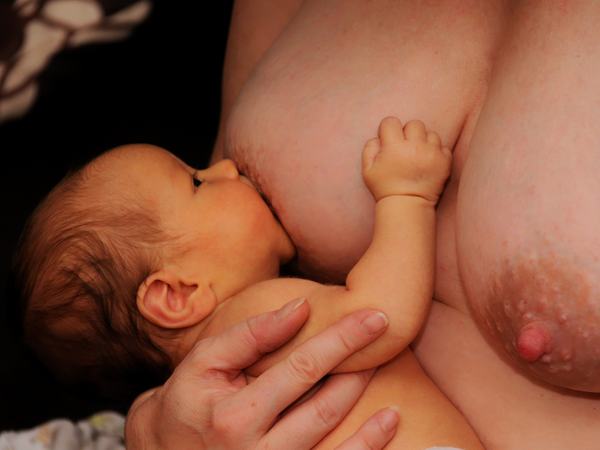
There should therefore be more breast on the lower jaw so that the chin is directly on the breast. More should then be visible from the upper areola than from the lower side (as seen from the baby).
Bulging lips
Lips that are not bulging out are often caused by errors during breastfeeding. If you push the breast into your baby's mouth instead of waiting until the mouth is really wide open, the lips are often not properly turned out or even curled inwards. This can also happen if the nipple is in a central position when docking.
Bulging lips serve to provide stability during breastfeeding. Your baby does not have to exert much pressure to hold the breast due to the wide support surface. This makes it much easier for your baby and you will probably feel less pressure.
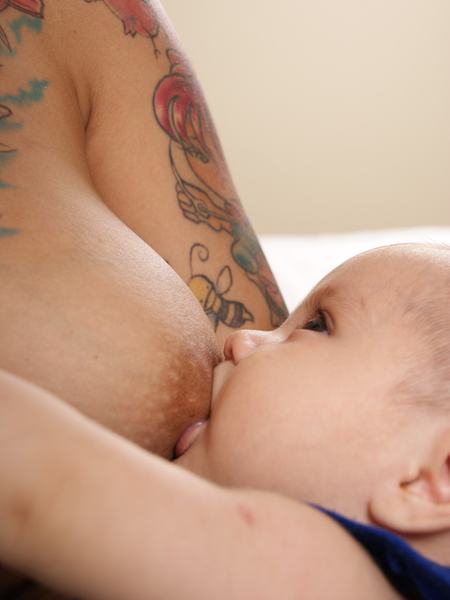
Sometimes a very short lip ligament means that your baby can't push out the upper lip properly.
Watch for early signs of hunger
If your baby is already very hungry when you latch on, it will make breastfeeding much more difficult. There's still a little Stone Age brain living inside our babies, and from their stage of development, they don't yet know that there's such a thing as need-feeding.
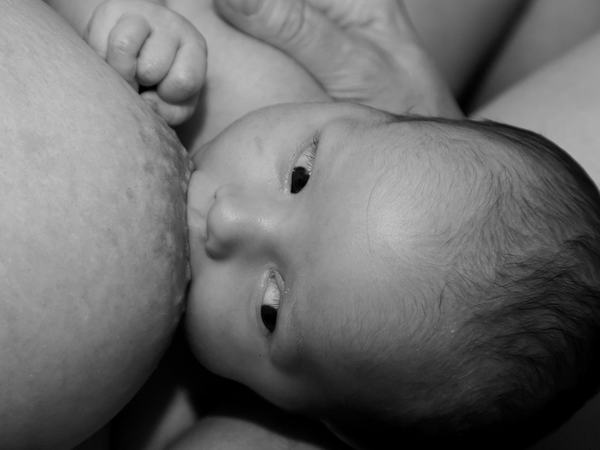
So if your baby is really hungry, he may be stressed and in his excitement he may not be able to concentrate well on breastfeeding. So it's better to watch for early hunger signs and get your baby latched on as soon as possible.
Early signs of hunger include sucking sounds or sucking movements of the lips. Your baby may also be turning his head, crossing his lips with his tongue, smacking his lips, or making other mouth or tongue movements.
If your baby hasn't had milk yet, his signs are becoming more obvious. He may put his hand in his mouth, become noticeably more active or even restless, and his sounds will change from smacking to more like whimpering. In addition, many babies make distinct searching movements with their heads here.
Finally, late hunger signs include crying and loud crying. Your baby is likely to be tense all over at this stage and is clearly visibly and audibly seeking attention, care, and eventually milk.
Other aspects
If you are holding your breast while breastfeeding, make sure you have enough distance to your baby's mouth. Otherwise, you will easily pull the breast out of your baby's mouth or your fingers will be in the way while sucking. It won't have the opportunity to get a good grip on the breast and suck effectively.
You can learn how to tell that your baby is breastfeeding effectively in my article 7 Signs You Can Tell Your Baby Is Breastfeeding Effectively.
Many moms squeeze the breast a bit to make it easier for their baby to dock. It's important to do this so that it's parallel to the jaw. Otherwise, it will be even harder for your baby to grasp the breast.
Also, make sure that you let go here after docking, because otherwise you will pull the breast out of your mouth, as I described above.
How to tell if your baby is not latched on properly
You may be wondering right now if you are latching your baby on correctly while breastfeeding. I have therefore collected some clues that may indicate that latching on is not good.
Pain during breastfeeding
Do you have constant pain during breastfeeding? Then something is going wrong. Pain during breastfeeding can have very diverse causes. However, the most common cause of pain is due to errors in latching on.
Especially if your baby does not have enough breast tissue in his mouth and the nipple rubs against the hard palate of your baby, it hurts. Also, if the lips are not turned out and your baby has to apply increased pressure to hold the breast, this can cause pain.
Ran-away behavior
If your baby is constantly slipping off the breast and then trying to find it again, it can have a number of causes. One possible cause is that it's not being held well and isn't close enough to your body.
If your baby exhibits ran-away behavior toward the end of the breastfeeding session, it is probably related to his eliminations. Sucking on the breast triggers an elimination reflex at the same time, so many small babies pee and/or poop right when they nurse. However, many babies find it difficult to concentrate on both breastfeeding and elimination at the same time, which is why they become restless while breastfeeding.
Another possible cause of constant and persistent ran-away behavior is restrictions caused by the lingual frenulum. Your baby may find it difficult to hold the breast and build up a vacuum, repeatedly slipping off the breast and then trying to grasp it again. You can read more about the lingual frenulum in my article The (too) short lingual frenulum.
Dimples during breastfeeding
If your baby is working with the cheek muscles while breastfeeding, you can sometimes recognize this by the dimples that form. In this case, make sure that you hold your baby close enough, that the mouth is wide open, that the lips are stretched out and that your baby has a lot of breast tissue in the mouth.
If dimpling or cheek work continues to be evident even with correct latch-on, look to see what the cause is. Again, one possible cause is a restriction caused by the lingual frenulum. If the tongue cannot work adequately, your baby may be using other areas of the body to receive milk from the breast.
Consistently fast sucking pattern
In a good latch-on with adequate milk transfer, sucking should be very fast only at the beginning. By sucking fast in the beginning, your baby triggers the milk-giving reflex in you. Once the milk-giving reflex is triggered, sucking should become slower and deeper. Your baby may also take short breaks from sucking.
If your baby is not well latched on, especially if you are breastfeeding in an uncomfortable position, your baby's sucking may be the same speed all the time.
Some moms think that if the baby is sucking consistently fast, that the amount of milk is too low. Often, this is not the case; it is simply due to difficulty latching on.
Deformed nipples
In some women, the nipples are deformed or bruised after breastfeeding. Sometimes they are even white and hardly supplied with blood due to the severe deformation.
The reason for this may then be that your baby has too little breast tissue in the mouth and the chin is not against the breast. In this case, the nipple is pressed against the hard palate when sucking, which can cause pain and the deformities of the nipple.
Another cause of nipple deformities after breastfeeding is, for example, a too short lingual frenulum. White discoloration of the nipple can be accompanied by vasospasm, a short-term disturbance of blood flow, if the baby is latched on correctly.
Video about correct latching on
Now I have given you a lot of information and tips on correct latch-on and how you can tell if your baby is not latched on correctly. In the following video you will find some aspects of this. In addition, you can see a lot of things again with the help of pictures.
If you still have questions about latching on or if problems cannot be solved on your own, you can contact a trained lactation consultant who will help you with your concerns.
Image sources
- Cover image: pixabay.com
- Image 1: pixabay.com
- Image 2: pixabay .com
- Image 3: pixabay .com
- Image 4: pixabay .com
- Image 5: pixabay.com
No comments yet.